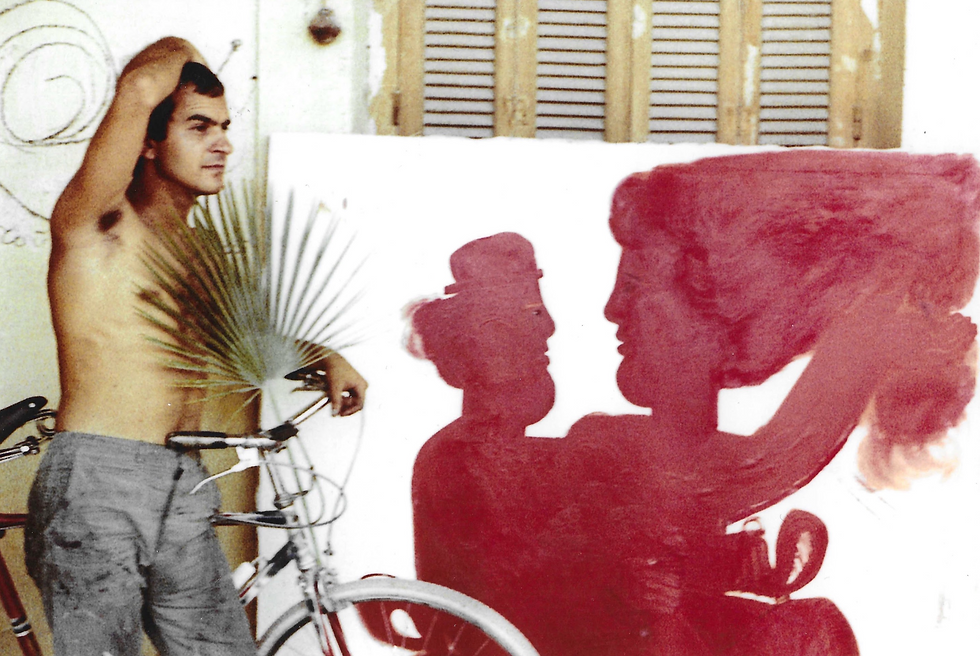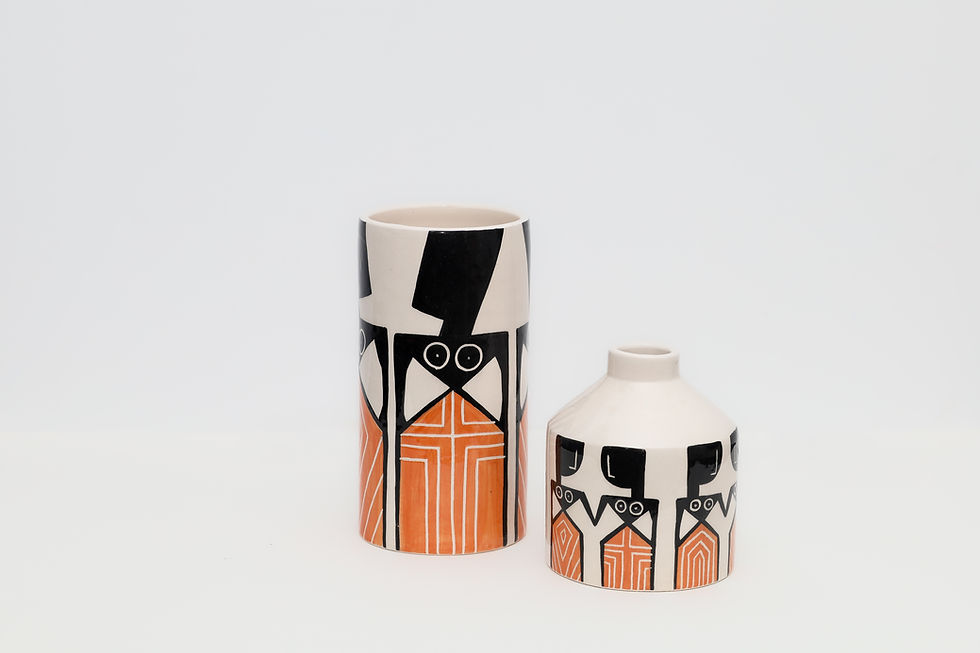A Man & His Rollei Discover 1950s Greece: Editor Interview with Robert McCabe
- Portes Magazine

- Jan 31, 2021
- 7 min read
Updated: Feb 2, 2021
“In 1961, my brother and I were driving from Ioannina to Metsovo. We stopped in Ano Peristeri to take some photographs of an old arched stone bridge next to the modern bridge. I photographed three spirited little girls in dresses held together with safety pins. They had charm that could not be measured, with warm smiles for the unexpected visitors. More than 50 years later...we met the three and rephotographed them next to the lake in Ioannina,” - Robert McCabe

Robert McCabe ©
EARLY BEGINNINGS
___________________________
When he was gifted a Kodak Baby Brownie by his father at the age of five, Robert McCabe was destined to become the great photographer who captured a raw, romantic modern Greece. "[the camera] used 127 film and you turned a small knob to advance the film. It was fixed focus, fixed exposure," he recalls.
Born in Chicago in 1934, McCabe and his family moved east when his father became the publisher of a picture newspaper in New York. "Of course from the start, my interest was in finding newsworthy subjects," he says. "When a huge hurricane hit the New York area, my older brother and I decided to visit Playland, the amusement park in Rye, NY, that is on Long Island, to see what had happened. It was a shocking scene of a tugboat and barge washed ashore, and the sea still covering the beach. I took photos. The negatives are lost but a couple prints survived."
McCabe's lens has throughout the years captured the essence of our collective human existence, and the wonders of the natural world. From the brightly colored streets of Havana, Cuba, to the endless snowy-white plains of Antarctica, McCabe has traveled the globe, preserving unique moments with the click of his camera.

Robert McCabe ©
OF DARKROOMS & PHOTO TECHNOLOGY
______________________________________________
The art and science of photography has changed drastically since McCabe began collecting black and white memories in the 50s. Though exploring the output of various cameras is part of the photographer’s experience, McCabe expressed a bit of remorse for having temporarily taken on digital photography in the new technology’s earlier days.
"The early digital cameras I had were not very good, and I am sorry I used them instead of film," he says. "I have a collection of images I like, but the resolution is terrible. Today, digital cameras can do everything film can do and more. The chemical darkroom which I used to have with my brother is now just a memory of the smell of acetic acid, and the frustration of trying to get the exposure and dodging right with the enlarger."
Nowadays, the photographer prefers the company of a Nikon D800, also switching between a full frame Sony and Canon. "I am still searching for a digital camera that has the resolution of the Rolleiflex with Plus X film and Microdol developer, and which is portable without having an assistant to carry it," he says. "With the current speed of change and progress, I doubt it’s too far away."
The other side of the coin, McCabe says, is that his 60-year-old Rolleiflex works perfectly after all this time. "Some of the photos in my 2011 book on the Ramble in Central Park were taken with it. Can you imagine what today's digital cameras will look like in 60 years as technology races ahead?'"
For an "old timer" who cherishes the world of film and chemicals, today's "digital darkrooms" still carry a quality of pure magic about them, McCabe says. In some ways, digital technology has even served to enhance the blind spots of traditional photography. "There is one photo I could never print correctly no matter how hard I tried. It was a view of two men in a coffee shop window in Santorini framing the 1911 steamer the Aigaion. Today, working with a scan of the negative, it appears on the back cover of my new book about Santorini before tourism and before the great earthquake of 1956."
Robert McCabe ©
DISCOVERING GREECE WITH THE ROLLEI
______________________________________________
McCabe first traveled to Europe in 1954, traversing through France, Italy, and Greece on a photo tour. He returned to Greece again in 1955 and 1957 to photograph the Cyclades for National Geographic. Following several exhibits of his work, he published his first book, Metamorphosis, in 1979. Since then, McCabe has published over 15 books and catalogs, the majority of which reflect his travels and photography in Greece over a span of more than 50 years.
Back in the Greece of the 1950s and 60s, the young and inquisitive traveller walked the quaint roads of Athens and the Greek islands seeking his next snapshot with a piece of technology that was a sight very rare among locals. "Most everywhere we went, my camera evoked curiosity, and unlike in some other countries, people loved having their picture taken," McCabe says. "Many islands had no visitors in 1954 and 1955, so people were very curious about where you came from and how much money you were making."
As the saying goes, a picture is worth a thousand words, and for McCabe, the pictures he took in Greece are accompanied by noteworthy stories. "In 1961 my brother and I were driving from Ioannina to Metsovo. We stopped in Ano Peristeri to take some photographs of an old arched stone bridge next to the modern bridge. I photographed three spirited little girls in dresses held together with safety pins. They had charm that could not be measured, with warm smiles for the unexpected visitors. More than 50 years later, I was having an exhibition at the Monodendri Rizarios Exhibition Center in Zagorochorio, curated by Takis Anagnostopoulos. He decided to make a banner and a poster with the three girls. One of the posters was in the Lake Hotel in Ioannina. The husband of one of the girls was there and spotted his wife in the poster! Soon we met the three and rephotographed them next to the lake in Ioannina."
While McCabe's black and white photos of Greece capture moments of an era passed, many of those elements - the olive trees, the ancient ruins, simple island architecture - are still with us today. Despite the continued existence of these core characteristics, as witness to the rapid development, industrialization, and tourism that boomed over time, McCabe expresses a sense of nostalgia for a lifestyle nearly forgotten.
"The old simple way of life was not an easy one. We have to admire those people who worked rocky fields with limited water supplies or who had flocks of goats or sheep. When you think about the Aegean islands you realize that for 3,000 years very little changed. In 1954 there were no motor vehicles, no electricity, no tourism. So while there are places that might seem frozen in time to a younger person, I see great progress in housing, plumbing, sewerage, telecommunications, television, food supplies, transportation, electricity, etc." he says.
"Yes, those olive groves and old stone houses maintain their magic, but the traditional landscape has been disfigured by modern villas in many places and in many of the most beautiful and traditional places like Patmos, the landscape is threatened by illegal as well as legal building. In Patmos, what I used to call the most beautiful walk in the world is now just a busy highway. Very sad," he notes. "Fortunately Greece has many beautiful places that have not been inundated with tourism yet. Even in some of the magnificent archaeological sites like Delphi, Mycenae or the Acropolis, if you go late in the afternoon before closing, after the tour bus people have left, you can often rediscover the tranquillity and inspiration that a site can evoke."

THE JOURNEY CONTINUED
________________________________
Reflecting on his many trips around the world, McCabe recalls a lesson learned on his journey to the Antarctic. That not all equipment, or technicians, are built the same.
"Just half kidding, I learned that you can't trust New York's most renowned camera repair shop to winterize a camera for the Antarctic!" he says. "I brought a Rolleiflex and a Contax with a focal plane shutter. When I was outside for a few minutes, the Contax shutter would often freeze. Thus, I unfortunately lost some images. The Rollei was perfect. I also learned that the U.S. Navy has incredible people and leadership. It was a great privilege to have been invited to photograph their operations in the Antarctic," he says.
Among the challenges a photographer may face, perhaps a frozen camera is not the greatest. After difficulty finding a good publisher in the U.S. who would take on sharing his wonderful images, McCabe said he managed to turn his luck around through the guidance of Greek-American photographer Costa Manos, who introduced McCabe to Jim Mairs of W.W. Norton. "I immediately found a home at Jim's own Quantuck Lane Press. The appreciation of images of a vanished era is very rewarding for me," he says.
On the topic of publishing, McCabe's latest work Santorini: Portrait of a Vanished Era (2020), gives readers a glimpse into the life and landscapes of a time before hyped tourism and even before the earthquake of 1956. In his collaboration with renowned Greek journalist Margarita Pournara, whose grandmother came from Santorini, the book elegantly captures life when a young McCabe and his brother were inquisitive visitors on the island.
For McCabe, this collection lies among his favorites. "I am most proud of my black and white photos from the period 1954 to 1965 when I was using a Rolleiflex, when tourists were rare in Greece, and I was able to capture elements of the ancient ways of life and unique cultures that had developed in many parts of the country," he says.
Well into his 80s, McCabe continues to explore his passion, and currently plans for the publication of two upcoming books titled Portraits of the Greeks 1954-2017 and The Greeks and Their Seas.
Aside from his popular black and white snapshots of a raw Greece of the past, McCabe is working on two collections of New York photos. One reflects views from two windows in New York, capturing the four seasons and different times of day, possibly to be published in honor of sheltering at home during the pandemic outbreak, he says. The other is a collection of photos illustrating how the majority of Central Park visitors are focused on their smartphones rather than nature.
In capturing everything from people's everyday moments to the breathtaking landscapes, McCabe has in his possession, an extensive collection of photographs. With such a rich selection, it comes as no surprise that the photographer cannot choose a favorite. "I have a dozen or so that I really love. There is no single one I can point to," he says.
Having first visited Greece in 1954, McCabe says that for the first 65 years, he was simply a philhellene. Now, thanks to the Greek Consul General in Boston, McCabe has received his Greek Citizenship. "I was deeply honored by this and very proud to join my wife and children as citizens," he says.
McCabe, whose wife is Greek, has in recent years spent his time between Greece and New York, and says he has been fortunate enough to visit at least once a year. When he is away, what he misses the most, he says, is the Greek sunlight, sea, islands, and friends.
_____________________________ WORDS: Portes Magazine PHOTOS: Robert McCabe





























